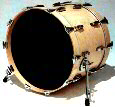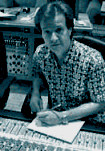 Boy do I ever have a huge backlog of links to post. Here are a few stories from the last few weeks relating to indie artists and the music industry.
Boy do I ever have a huge backlog of links to post. Here are a few stories from the last few weeks relating to indie artists and the music industry.
Can Music Survive Inside the Big Box, from the Wall Street Journal, discusses the increasing power of Walmart, Best Buy, and Target over the (traditional) music industry:
For his part, Best Buy’s Mr. Arnold says the blame for waning consumer interest in CDs lies with the record labels, not with stores like his. “Music has become a commoditized item,” he says. “The CD is perceived by the consumer to be a $10 item, and the manufacturers continue to release new titles at $15 to $18.98.” To remedy that situation, he says he has urged labels to move to a “paperback-book model,” with no-frills packages priced cheaply for most customers, and more deluxe presentations for die-hard fans.
The Album, a Commodity in Disfavor, from the NY Times, discusses the demise of the record album in pop music:
… fans are buying fewer and fewer full albums. In the shift from CDs to digital music, buyers can now pick the individual songs they like without having to pay upward of $10 for an album. Last year, digital singles outsold plastic CD’s for the first time. So far this year, sales of digital songs have risen 54 percent …
This short article from Bob Baker, The Truth About Music Industry Upheaval, caught my attention because it reminds us that history repeats. Sometimes, over and over:
We tend to think that whatever changes are taking place in the present moment are the biggest and most impactful ever. While it’s true that change occurs at ever increasing rates, and the music shift going on today is truly dramatic, it’s also important to realize that it’s nothing new.
It happened with the invention of the gramophone. It happened with swing and big band. It happened with Sinatra, Elvis and The Beatles. It happened with the introduction of the cassette and the CD. It happened again with the widespread use of MP3 files and iPods. It’s happening right now.
It seems at times that the major labels’ current woes are an entirely new challenge, unimaginable before broadband and Napster. But change is a constant in the music industry. Those best suited to capitalize on whatever comes next are the folks who recognize the patterns.
Carrie Underwood’s Big Accomplishment could be significant for indie artists, even if she’s the furthest thing from indie herself:
Before this week, the only way to get into the Billboard top 100 was to have a massive record distribution model that included major retail stores like Wal-Mart, Target, Tower Records, Sam Goody and the like. It required a ton of advertising money and an full on radio assault. But now we have a proof of concept that an exclusive online download can reach the sort of customers that only traditional record sales have reached in the past.
Sure, Underwood had the help of 30 million Idol viewers to reach the charts. But even a couple of years ago, her accomplishment would have been impossible. Underwood is mainstream writ large, and the appearance of her track on the Billboard chart illustrates broad mainstream acceptance of iTunes, and more importantly downloadable music. That’s a good thing for indies, large and small alike, who depend on digital distribution to reach fans and sell their music.
Finally, Andy’s conclusion in The New Music Industry resonated with me:
Bands can now release content at a more fevered and consistent pace, churning out a song every couple of months from the privacy of their own homes.
No longer will the artist need to write “filler†in order to artificially elongate their album. No longer will fans be forced to purchase 9 songs they don’t like in order to have 3 songs they love. No longer will fans have to wait years between albums. Fans will get a new dose of the band they love every time they write a new song.
Early adopters of this idea will benefit greatly by keeping their band in the media more often.
Especially for indie artists, music is a long tail market. As an indie, you’re not likely to sell a million copies of your album. But you might sell individual tracks a few hundred copies at a time. Grow your catalog of tracks, and suddenly a viable business presents itself. And add to that the increasing mainstream acceptance of paying for downloadable music (thanks, Ms. Underwood,) and it starts to look like a whole new business model …
Tags: music-business

 Brad posted a great article this week on which
Brad posted a great article this week on which  As an amateur recording engineer, you’ll likely run into the name Recorderman when learning how to mic a drum kit. Recorderman’s approach to placing overhead drum microphones is recommended for beginners because it’s easy to set up, and yields good, sometimes great, results in practically every situation.
As an amateur recording engineer, you’ll likely run into the name Recorderman when learning how to mic a drum kit. Recorderman’s approach to placing overhead drum microphones is recommended for beginners because it’s easy to set up, and yields good, sometimes great, results in practically every situation. Whether or not you’re in it for the money, making a few bucks with your music is a great feeling. I’ve been writing songs most of my life, and recording for the better part of the last decade. And while I’m not a professional, I’ve still earned enough over the years to warrant paying taxes as a musician and amateur recording engineer.
Whether or not you’re in it for the money, making a few bucks with your music is a great feeling. I’ve been writing songs most of my life, and recording for the better part of the last decade. And while I’m not a professional, I’ve still earned enough over the years to warrant paying taxes as a musician and amateur recording engineer. In Mix It Like A Record,
In Mix It Like A Record,  A web search for “best VST EQ” turns up dozens of pages that mention the Paris EQ VST, but for reasons I haven’t been able to figure out, the plugin and its author Matt Craig have dropped off the face of the Internet.
A web search for “best VST EQ” turns up dozens of pages that mention the Paris EQ VST, but for reasons I haven’t been able to figure out, the plugin and its author Matt Craig have dropped off the face of the Internet. Electronic Musician just added an
Electronic Musician just added an  Boy do I ever have a huge backlog of links to post. Here are a few stories from the last few weeks relating to indie artists and the music industry.
Boy do I ever have a huge backlog of links to post. Here are a few stories from the last few weeks relating to indie artists and the music industry.